Preparation of Tea Tree Oil Microcapsules and Their Effects on Strawberry Preservation During Storage
Abstract
1. Introduction
2. Materials and Methods
2.1. Experimental Materials and Reagents
2.2. Instruments and Equipment
2.3. Experimental Methods
2.3.1. Preparation of Tea Tree Oil Microcapsules
2.3.2. Experiment Preserving Strawberries Using Tea Tree Oil Microcapsules
2.4. Measurement Indicators
2.4.1. Encapsulation Efficiency Measurement
2.4.2. Slow-Release Measurement
2.4.3. Scanning Electron Microscopy
2.4.4. Major Component Analysis
Sample Preparation
GC–MS Analysis
Data Processing
2.4.5. Appearance, Weight Loss Rate, and Decay Index
2.4.6. Color and Firmness
2.4.7. Acidity-to-Brix Ratio
2.4.8. Anthocyanin Content
2.4.9. SOD, CAT, and APX Activity in Strawberries
2.5. Data Processing
3. Results and Discussion
3.1. Study on Preparation Process of Tea Tree Oil Microcapsules
3.1.1. Single-Factor Experiments
3.1.2. Optimization of Orthogonal Experiments
3.2. Analysis of Tea Tree Oil Microcapsule Characteristics
3.2.1. Morphological Analysis of Tea Tree Oil Microcapsules
3.2.2. Slow-Release Analysis of Tea Tree Oil Microcapsules
3.2.3. Component Analysis of Tea Tree Oil Microcapsules
3.3. Effects of Tea Tree Oil Microcapsules on Preservation of Strawberries
3.3.1. Effects of Tea Tree Oil Microcapsules on Appearance, Weight Loss Rate, and Decay Index of Strawberries
3.3.2. Effects of Tea Tree Oil Microcapsules on Color and Firmness of Strawberries
3.3.3. Effects of Tea Tree Oil Microcapsules on Soluble Solid Content and Acidity of Strawberries
3.3.4. Effects of Tea Tree Oil Microcapsules on Anthocyanin Content of Strawberries
3.3.5. Effects of Tea Tree Oil Microcapsules on Antioxidant Enzyme Activity in Strawberries
4. Conclusions
Author Contributions
Funding
Institutional Review Board Statement
Informed Consent Statement
Data Availability Statement
Conflicts of Interest
References
- Chu, Y.F.; Gao, C.C.; Liu, X.Y.; Zhang, N.; Xu, T.; Feng, X.; Yang, Y.L.; Shen, X.C.; Tang, X.Z. Improvement of storage quality of strawberries by pullulan coatings incorporated with cinnamon essential oil nanoemulsion. LWT 2020, 122, 109054. [Google Scholar] [CrossRef]
- Hajji, S.; Younes, I.; Affes, S.; Boufi, S.; Nasri, M. Optimization of the formulation of chitosan edible coatings supplemented with carotenoproteins and their use for extending strawberries postharvest life. Food Hydrocoll. 2018, 83, 375–392. [Google Scholar] [CrossRef]
- Chang, L.; Xu, L.; Yang, Z.; Yang, Z.; Liu, L.; Qiu, D. Antibacterial and antioxidative biogenic films for room-temperature strawberry preservation. Food Chem. 2023, 405, 134893. [Google Scholar] [CrossRef]
- Shahbazi, Y. Application of carboxymethyl cellulose and chitosan coatings containing Mentha spicata essential oil in fresh strawberries. Int. J. Biol. Macromol. 2018, 112, 264–272. [Google Scholar] [CrossRef]
- Priya, K.; Thirunavookarasu, N.; Chidanand, D.V. Recent advances in edible coating of food products and its legislations: A review. J. Agric. Food Res. 2023, 12, 100623. [Google Scholar] [CrossRef]
- Borotová, P.; Galovičová, L.; Vukovic, N.; Vuki, M.D.; Tvrdá, E.; Kaániováet, M. Chemical and biological characterization of Melaleuca alternifolia essential oil. Plants 2022, 11, 558. [Google Scholar] [CrossRef] [PubMed]
- Ren, J.; Wang, Y.M.; Zhang, S.B.; Lv, Y.Y.; Zhai, H.C.; Wei, S.; Ma, P.A.; Hu, Y.S. Terpinen-4-ol from tea tree oil prevents Aspergillus flavus growth in postharvest wheat grain. Int. J. Food Microbiol. 2024, 418, 110741. [Google Scholar] [PubMed]
- Isman, M.B. Commercial development of plant essential oils and their constituents as active ingredients in bioinsecticides. Phytochem. Rev. 2020, 19, 235–241. [Google Scholar]
- Deng, X.Z.; Wei, Y.Y.; Jiang, S.; Ye, J.F.; Chen, Y.; Xu, F.; Chen, J.H.; Shao, X.F. Recent advances in the application of tea tree oil in the storage of fruit and vegetables. Postharvest Biol. Technol. 2025, 219, 113260. [Google Scholar] [CrossRef]
- Jiang, S.; Zhao, T.T.; Wei, Y.Y.; Cao, Z.D.; Xu, Y.Y.; Wei, J.Y.; Xu, F.; Wang, H.F.; Shao, X.F. Preparation and characterization of tea tree oil/ hydroxypropyl-β-cyclodextrin inclusion complex and its application to control brown rot in peach fruit. Food Hydrocoll. 2021, 121, 107037. [Google Scholar]
- Maiti, T.K.; Parvate, S.; Dixit, P.; Singh, J.; Reddy, V.J.; Bhuvanesh, E.; Chattopadhyay, S. Liposome for encapsulation of essential oil and fatty acids. In Liposomal Encapsulation in Food Science and Technology; Taylor & Francis: Oxford, UK, 2023; pp. 113–124. [Google Scholar]
- Wang, Y.S.; Wu, C.; Yang, W.; Gong, Y.X.; Zhang, X.Y.; Li, J.L.; Wu, D.M. Dual cross-linking with tannic acid and transglutaminase improves microcapsule stability and encapsulates lemon essential oil for food preservation. Food Chem. 2025, 465 Pt 2, 142173. [Google Scholar] [CrossRef] [PubMed]
- Niu, Y.W.; Wu, J.H.; Kang, Y.X.; Zhao, Q.X.; Xiao, Z.B.; Zhao, D. Encapsulation technique and application progress of mechanical stimuli-responsive microcapsules. Prog. Org. Coat. 2023, 176, 107390. [Google Scholar]
- Benegra, M.; Couto, G.H.; Pangoncellim, G.B. Preparation and evaluation of w/o/w type emulsions for encapsulation of citronella essential oil by inverse ionic gelation. Colloid Polym. Sci. 2023, 301, 1159–1170. [Google Scholar] [CrossRef]
- Zong, X.Y.; Li, H.; Tang, Q.; Wang, X.; Li, Y.; Li, L. Preparation and characterization of glucoamylase microcapsules prepared by W/O/W type complex coacervation freeze drying. J. Food Sci. 2023, 88, 795–809. [Google Scholar] [CrossRef] [PubMed]
- Li, Z.A.; Jiang, L.W.; Wang, Y.Y.; Li, M.; Liu, T.T.; Liu, Y.Z. Chitosan—gellan gum polyelectrolyte hydrogel beads containing tea tree oil microcapsules: Preparation, characterization and application. Food Hydrocoll. 2024, 157, 110464. [Google Scholar] [CrossRef]
- Hădărugă, N.G.; Szakal, R.N.; Chirilă, C.A.; Lukinich-Gruia, A.T.; Păunescu, V.; Muntean, C.; Rusu, G.; Bujancă, G.; Hădărugă, D.I. Complexation of Danube common nase (Chondrostoma nasus L.) oil by β-cyclodextrin and 2-hydroxypropyl-β-cyclodextrin. Food Chem. 2020, 303, 125419. [Google Scholar] [CrossRef]
- Deng, C.Y.; Cao, C.; Zhang, Y.Y.; Hu, J.W.; Gong, Y.Q.; Zheng, M.M.; Zhou, Y.B. Formation and stabilization mechanism of β-cyclodextrin inclusion complex with C10 aroma molecules. Food Hydrocoll. 2022, 123, 107013. [Google Scholar] [CrossRef]
- Kong, P.; Abe, J.P.; Masuo, S.; Enomae, T. Preparation and characterization of tea tree oil-β-cyclodextrin microcapsules with super-high encapsulation efficiency. J. Bioresour. Bioprod. 2023, 8, 224–234. [Google Scholar] [CrossRef]
- Esteve-Redondo, P.; Heras-Mozos, R.; López-Carballo, G.; López-Carballo, G.; López-de-Dicastillo, C.; Gavara, R.; Hernández-Muñoz, P. Efficacy of methyl anthranilate vapour against Botrytis cinerea in packaged strawberries. Food Packag. Shelf Life 2024, 45, 101349. [Google Scholar]
- Zhang, Y.; Lin, B.; Tang, G.; Chen, Y.; Deng, M.; Lin, Y.; Li, M.; He, W.; Zhang, Y.; Luo, Y.; et al. Application of γ-aminobutyric acid improves the postharvest marketability of strawberry by maintaining fruit quality and enhancing antioxidant system. Food Chem. X 2024, 21, 101252. [Google Scholar]
- Li, Z.B.; Wei, Y.Y.; Xu, Y.Y.; Han, P.P.; Jiang, S.; Xu, F.; Wang, H.F.; Tao, N.G.; Shao, X.F. Terpinen-4-ol treatment maintains quality of strawberry fruit during storage by regulating sucrose-induced anthocyanin accumulation. Postharvest Biol. Technol. 2021, 174, 111461. [Google Scholar] [CrossRef]
- Yang, Z.; Li, M.; Zhai, X.; Zhao, L.; Elrasheid Tahir, H.; Shi, J.; Zou, X.; Huang, X.; Li, Z.; Xiao, J. Development and characterization of sodium alginate/tea tree essential oil nanoemulsion active film containing TiO2 nanoparticles for banana packaging. Int. J. Biol. Macromol. 2022, 213, 145–154. [Google Scholar] [CrossRef]
- Lu, M.; Yang, H.; Li, C.; Zhang, Z.; Zhang, L.; Xiong, C.; Wang, L.; Xie, Y.; Xu, J. Preparation of tea tree essential oil and β-cyclodextrin inclusion complex and analysis of its storage stability. Packag. Food Mach. 2019, 37, 31–36. (In Chinese) [Google Scholar]
- An, P.; Yang, X.; Yu, J.; Qi, J.; Ren, X.; Kong, Q. α-terpineol and terpene-4-ol, the critical components of tea tree oil, exert antifungal activities in vitro and in vivo against Aspergillus niger in grapes by inducing morphous damage and metabolic changes of fungus. Food Control 2019, 98, 42–53. [Google Scholar] [CrossRef]
- Wigati, L.P.; Wardana, A.A.; Jothi, J.S.; Leonard, S.; Thi Van, T.; Yan, X.; Tanaka, F.; Tanaka, F. Biochemical and color stability preservation of strawberry using edible coatings based on jicama starch/calcium propionate/agarwood bouya essential oil during cold storage. J. Stored Prod. Res. 2024, 107, 102324. [Google Scholar] [CrossRef]
- Catanzano, O.; Straccia, M.C.; Miro, A.; Ungaro, F.; Romano, I.; Mazzarella, G.; Santagata, G.; Quaglia, F.; Laurienzo, P.; Malinconico, M. Spray-by-spray in situ cross-linking alginate hydrogels delivering a tea tree oil microemulsion. Eur. J. Pharm. Sci. 2015, 66, 20–28. [Google Scholar] [CrossRef] [PubMed]
- Huang, Y.; Liao, M.; Yang, Q.Q.; Xiao, J.J.; Hu, Z.Y.; Zhou, L.J.; Cao, H.Q. Transcriptome profiling reveals differential gene expression of detoxification enzymes in Sitophilus zeamais responding to terpinen-4-ol fumigation. Pestic. Biochem. Physiol. 2018, 149, 44–53. [Google Scholar] [CrossRef] [PubMed]
- Sathiyaseelan, A.; Saravanakumar, K.; Mariadoss, A.V.A.; Ramachandran, C.; Hu, X.; Oh, D.H.; Wang, M.H. Chitosan-tea tree oil nanoemulsion and calcium chloride tailored edible coating increase the shelf life of fresh cut red bell pepper. Prog. Org. Coat. 2021, 151, 106010. [Google Scholar] [CrossRef]
- Chen, Y.; Xing, M.Y.; Chen, T.; Tian, S.P.; Li, B.Q. Effects and mechanisms of plant bioactive compounds in preventing fungal spoilage and mycotoxin contamination in postharvest fruits: A review. Food Chem. 2023, 30, 135787. [Google Scholar] [CrossRef]
- Huan, C.; Han, S.; Jiang, L.; An, X.; Yu, M.; Xu, Y.; Ma, R.; Yu, F. Postharvest hot air and hot water treatments affect the antioxidant system in peach fruit during refrigerated storage. Postharvest Biol. Technol. 2017, 126, 1–14. [Google Scholar] [CrossRef]
- Li, D.; Ye, Q.; Lei, J.; Luo, Z. Effects of nano-TiO2-LDPE packaging on postharvest quality and antioxidant capacity of strawberry (Fragaria ananassa Duch) stored at refrigeration temperature. J. Sci. Food Agric. 2017, 97, 1116–1123. [Google Scholar] [CrossRef] [PubMed]
- Wei, Y.; Shao, X.; Wei, Y.; Xu, F.; Wang, H. Effect of preharvest application of tea tree oil on strawberry fruit quality parameters and possible disease resistance mechanisms. Sci. Hortic. 2018, 241, 18–28. [Google Scholar] [CrossRef]


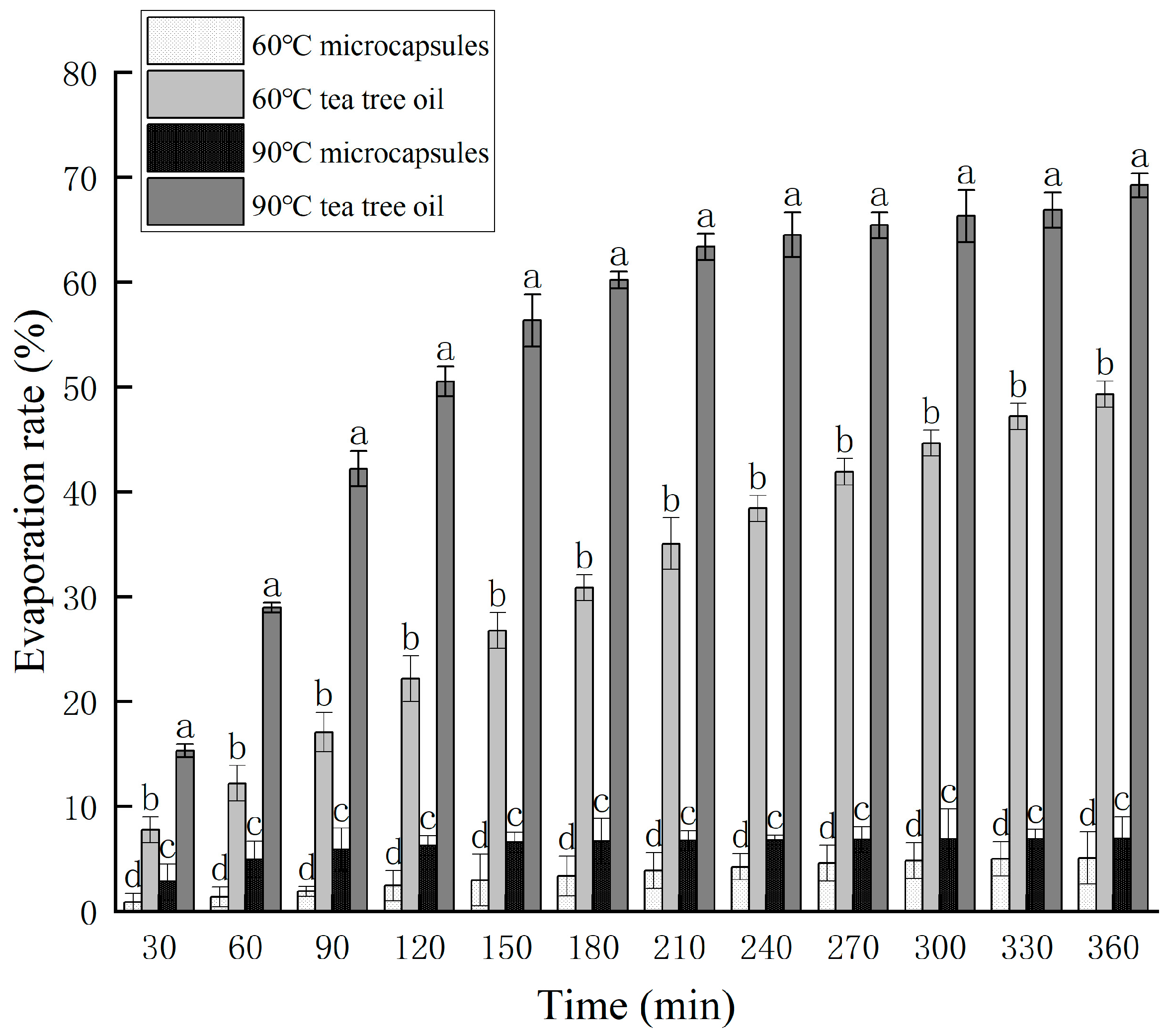


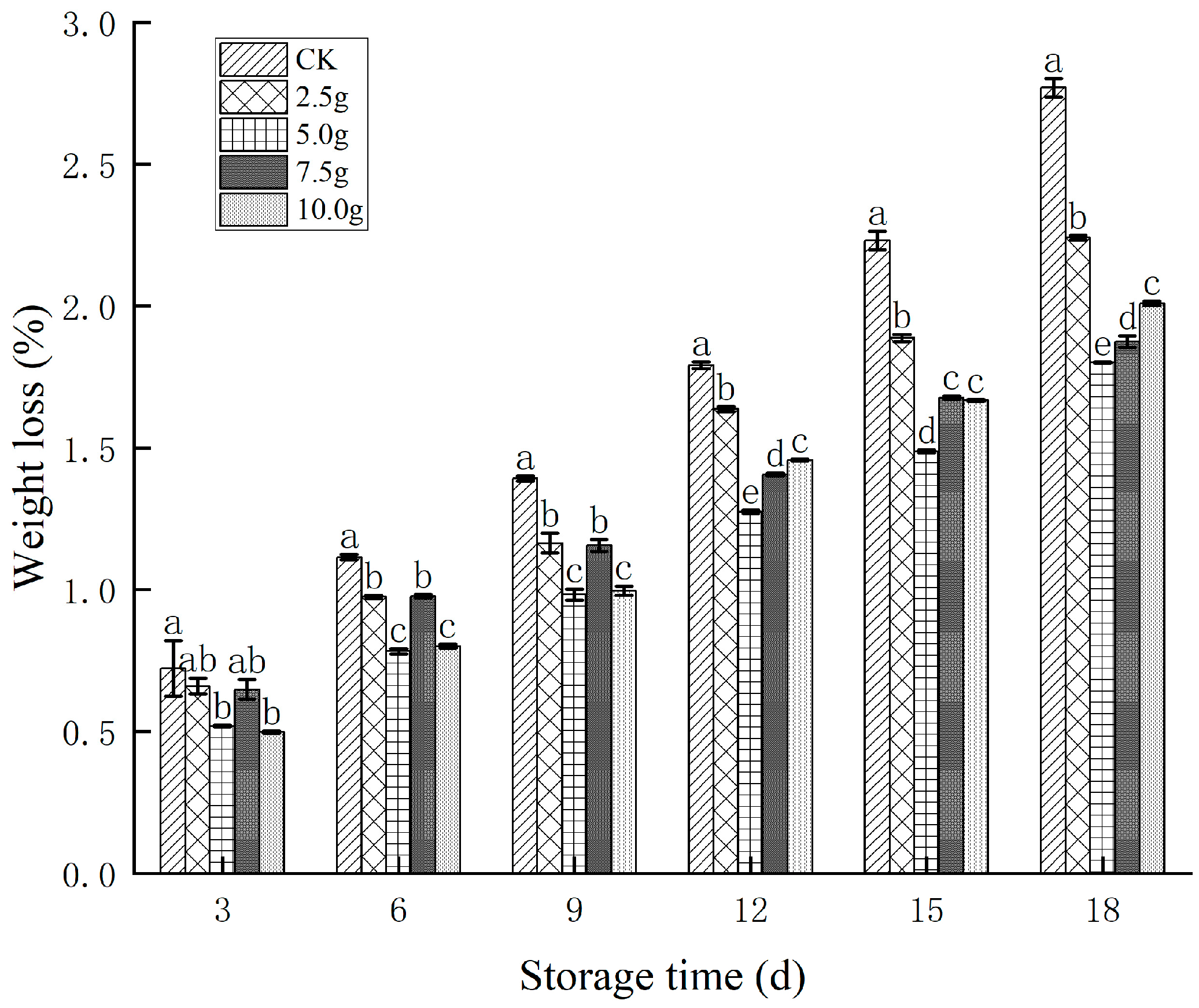
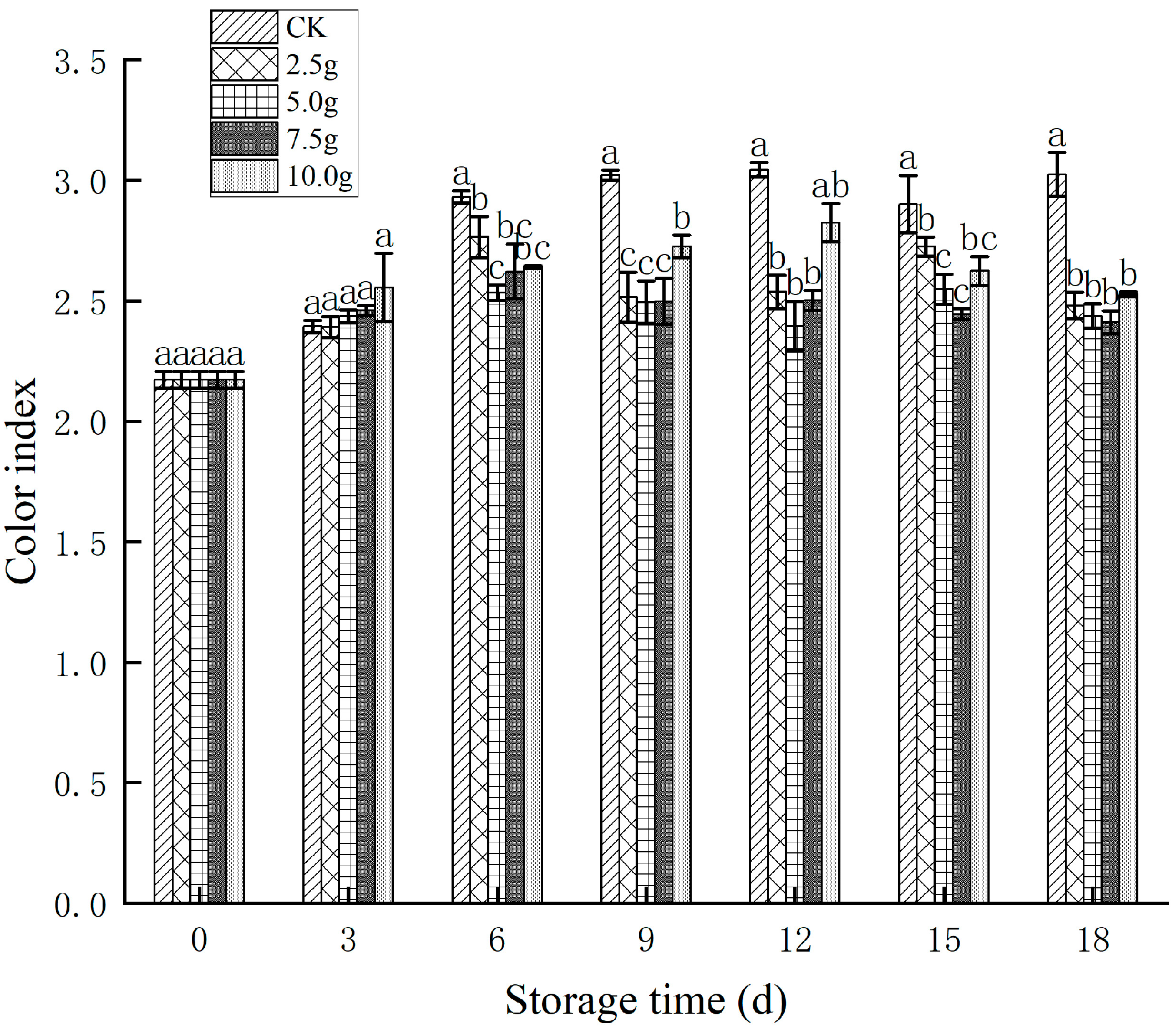

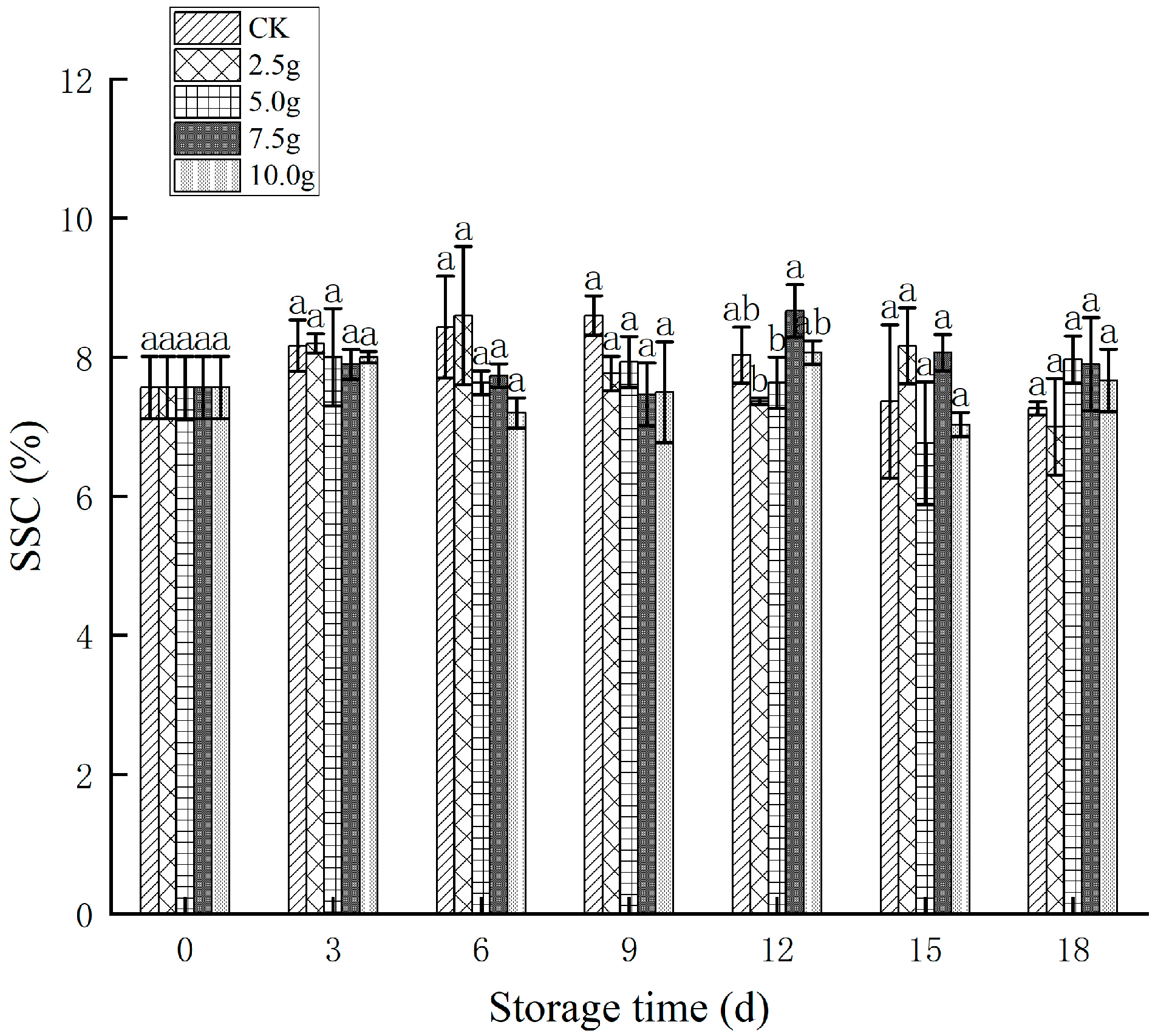
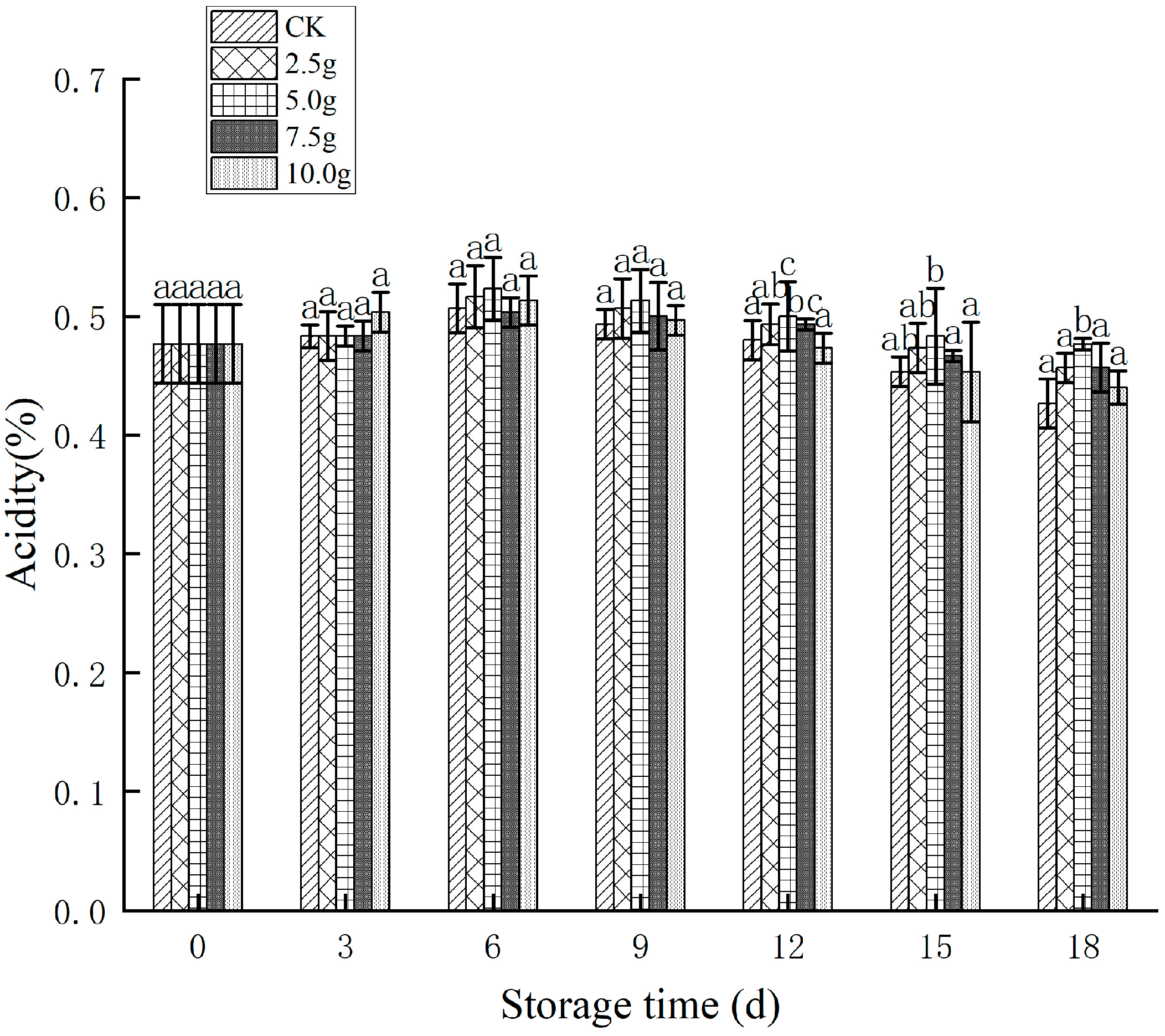


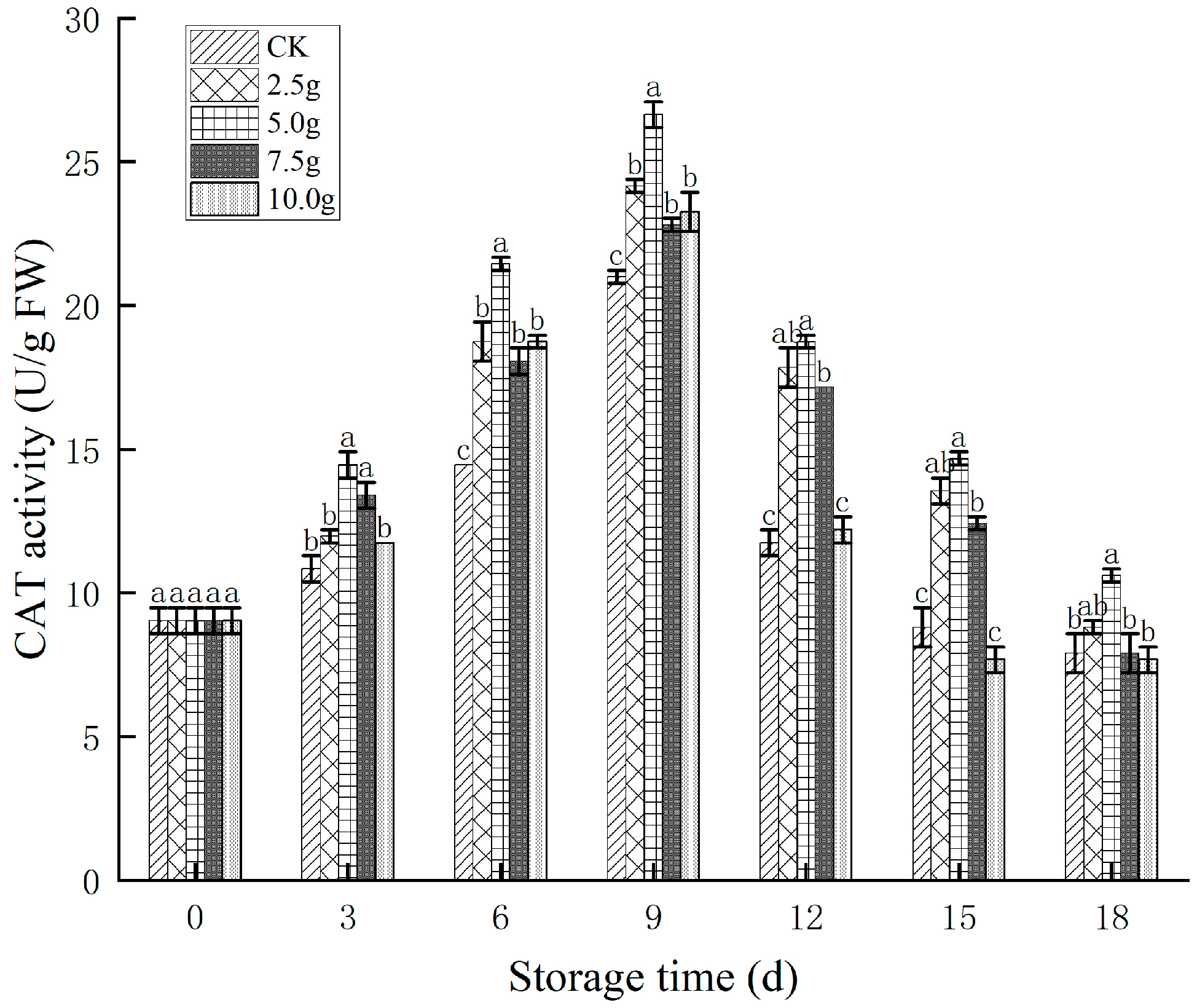
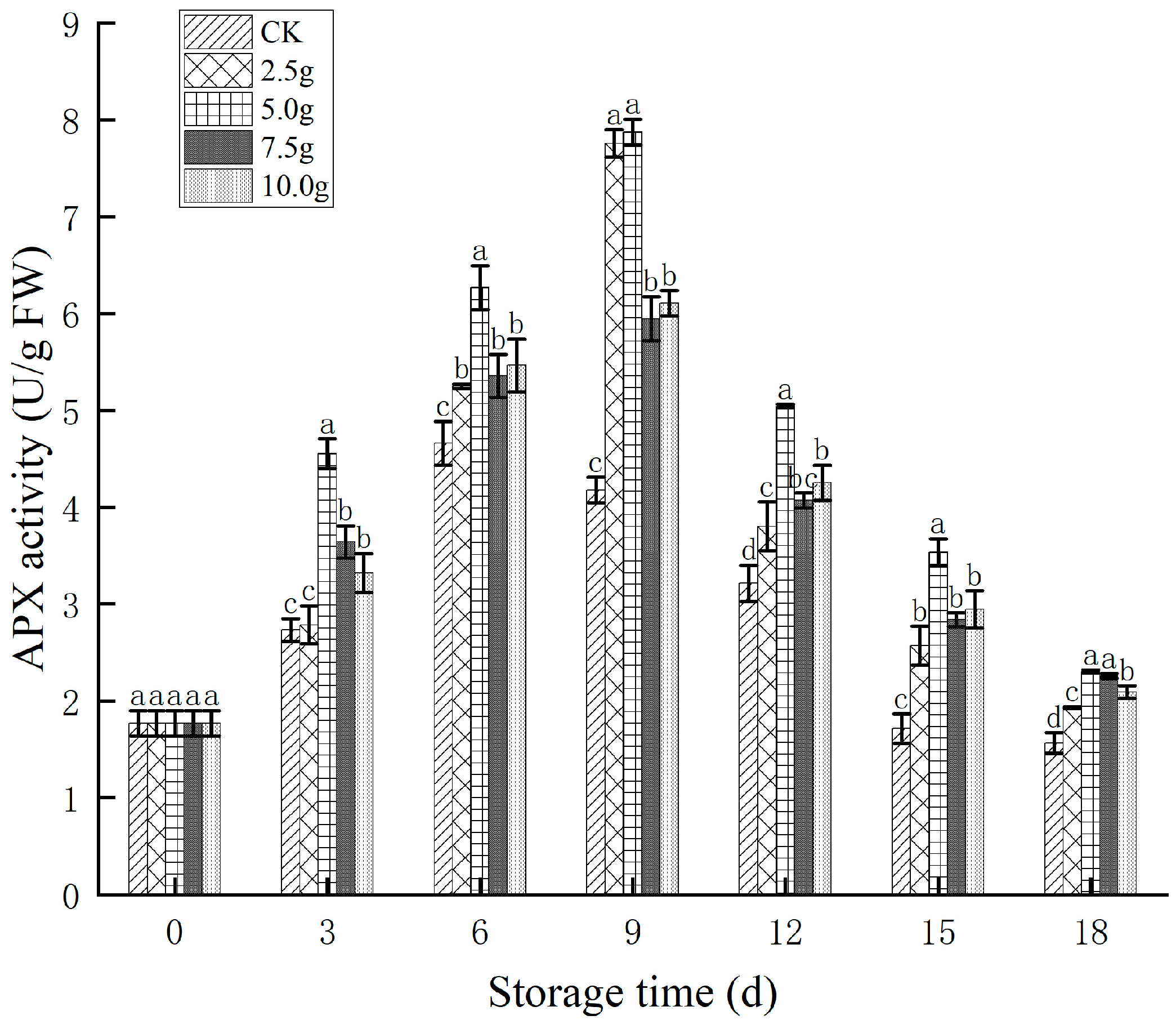
| Level | A. Montmorillonite Addition (%) | B. Core-to-Wall Ratio | C. Encapsulation Temperature (°C) | D. Encapsulation Time (min) |
|---|---|---|---|---|
| 1 | 2% | 1:8 | 70 | 30 |
| 2 | 4% | 1:10 | 80 | 60 |
| 3 | 6% | 1:12 | 90 | 90 |
| Factor | A. Montmorillonite Concentration/% | B. Core-to-Wall Ratio | C. Encapsulation Temperature/°C | D. Encapsulation Time/min | Encapsulation Efficiency/% Trial I Trial II Trial III | ||
|---|---|---|---|---|---|---|---|
| 1 | 2% | 1:8 | 70 | 30 | 49.39 | 48.60 | 48.17 |
| 2 | 2% | 1:10 | 80 | 60 | 62.64 | 64.44 | 65.97 |
| 3 | 2% | 1:12 | 90 | 90 | 77.65 | 75.23 | 78.94 |
| 4 | 4% | 1:8 | 90 | 60 | 51.26 | 52.92 | 51.26 |
| 5 | 4% | 1:10 | 70 | 90 | 67.50 | 71.37 | 69.21 |
| 6 | 4% | 1:12 | 80 | 30 | 73.79 | 74.26 | 72.60 |
| 7 | 6% | 1:8 | 80 | 90 | 52.42 | 50.54 | 54.43 |
| 8 | 6% | 1:10 | 90 | 30 | 64.89 | 66.33 | 68.85 |
| 9 | 6% | 1:12 | 70 | 60 | 73.54 | 74.73 | 71.60 |
| K1 | 63.45 | 51.00 | 63.79 | 62.99 | |||
| K2 | 64.91 | 66.80 | 63.45 | 63.15 | |||
| K3 | 64.15 | 74.70 | 65.26 | 66.37 | |||
| R | 1.46 | 23.70 | 1.81 | 3.38 | |||
| Source | Type 3 Sum of Squares | Degree of Freedom | Mean Square | F | Significance |
|---|---|---|---|---|---|
| Adjusted Models | 2713.532 | 8 | 339.192 | 136.218 | 0.000 |
| Intercept | 111,173.370 | 1 | 111,173.370 | 44,646.810 | 0.000 |
| A | 9.611 | 2 | 4.806 | 1.930 | 0.174 |
| B | 2621.978 | 2 | 1310.989 | 526.488 | 0.000 ** |
| C | 16.600 | 2 | 8.300 | 3.333 | 0.059 |
| D | 65.342 | 2 | 32.671 | 13.121 | 0.000 ** |
| Error | 44.821 | 18 | 2.490 | ||
| Total | 113,931.724 | 27 | |||
| Adjusted Total | 2758.353 | 26 |
| Major Component | Content in Pure Tea Tree Oil (%) | Content in Microcapsules (%) |
|---|---|---|
| Terpinen-4-ol | 35.61 ± 5.85 a | 29.76 ± 3.13 a |
| p-Cymene | 12.69 ± 1.01 a | 11.78 ± 0.67 a |
| Terpinolene | 12.21 ± 0.73 a | 10.49 ± 1.55 a |
| 1,8-Cineole | 10.53 ± 0.21 a | 10.11 ± 0.48 a |
| 3-Carene | 8.28 ± 1.12 a | 7.80 ± 0.98 a |
| Terpinene | 6.70 ± 0.31 a | 5.45 ± 1.57 a |
| α-Pinene | 3.59 ± 0.05 a | 3.62 ± 0.16 a |
| α-Terpineol | 3.55 ± 0.36 a | 3.02 ± 0.17 a |
| γ-Terpinene | 2.74 ± 0.51 a | 2.24 ± 0.22 a |
| (+)-Limonene | 2.22 ± 0.03 a | 0.91 ± 0.01 b |
Disclaimer/Publisher’s Note: The statements, opinions and data contained in all publications are solely those of the individual author(s) and contributor(s) and not of MDPI and/or the editor(s). MDPI and/or the editor(s) disclaim responsibility for any injury to people or property resulting from any ideas, methods, instructions or products referred to in the content. |
© 2025 by the authors. Licensee MDPI, Basel, Switzerland. This article is an open access article distributed under the terms and conditions of the Creative Commons Attribution (CC BY) license (https://creativecommons.org/licenses/by/4.0/).
Share and Cite
Han, Y.-L.; Chen, C.; Wu, Y.-Y.; Yan, Y.-M.; Wang, M.-Y.; Xiang, Y.; Wei, D.-Y.; Hu, Z.-H.; Zhuang, J.; Xiong, A.-S.; et al. Preparation of Tea Tree Oil Microcapsules and Their Effects on Strawberry Preservation During Storage. Horticulturae 2025, 11, 389. https://doi.org/10.3390/horticulturae11040389
Han Y-L, Chen C, Wu Y-Y, Yan Y-M, Wang M-Y, Xiang Y, Wei D-Y, Hu Z-H, Zhuang J, Xiong A-S, et al. Preparation of Tea Tree Oil Microcapsules and Their Effects on Strawberry Preservation During Storage. Horticulturae. 2025; 11(4):389. https://doi.org/10.3390/horticulturae11040389
Chicago/Turabian StyleHan, Yan-Li, Cen Chen, Yuan-Yue Wu, Yu-Meng Yan, Meng-Ying Wang, Yang Xiang, Dao-Yu Wei, Zhi-Hang Hu, Jing Zhuang, Ai-Sheng Xiong, and et al. 2025. "Preparation of Tea Tree Oil Microcapsules and Their Effects on Strawberry Preservation During Storage" Horticulturae 11, no. 4: 389. https://doi.org/10.3390/horticulturae11040389
APA StyleHan, Y.-L., Chen, C., Wu, Y.-Y., Yan, Y.-M., Wang, M.-Y., Xiang, Y., Wei, D.-Y., Hu, Z.-H., Zhuang, J., Xiong, A.-S., & Wang, Y.-H. (2025). Preparation of Tea Tree Oil Microcapsules and Their Effects on Strawberry Preservation During Storage. Horticulturae, 11(4), 389. https://doi.org/10.3390/horticulturae11040389







